Practical and durable signage is crucial for branding businesses in Australia’s diverse climate. In this situation, the choice of signage materials can make a big difference.
The popular signage materials that are used to make signs include the following.
- Vinyl (PVC, PVAc)
- Mesh
- Corflute
- Acrylic
- Aluminium Composite Material (ACM)
- Aluminium
- Steel
- Brass
- Wood
- Foamboard/Foam Core Board
In this guide, we will explore different materials of signage made of. We will also describe their characteristics, key benefits, and popular use. So you can choose the suitable signage material for your business branding.
In-Depth Exploring of Different Signage Materials
The different types of signboard material options are discussed in detail as follows.
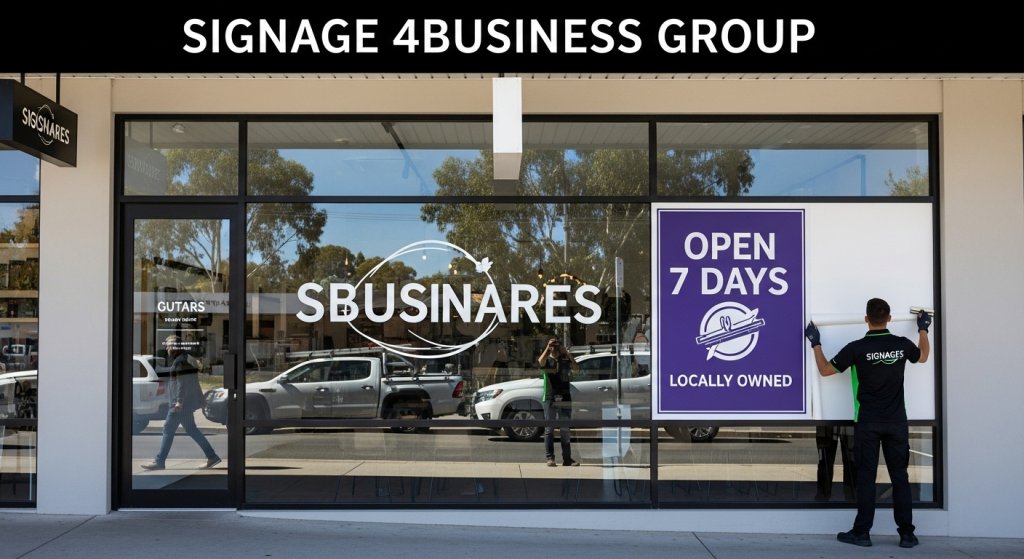
01. Vinyl Signage (PVC, PVAc)
Vinyl signage is the most popular signage material, mainly made of PVC (Polyvinyl Chloride).
PVC is highly durable, UV-resistant, versatile, and customisable. These make it ideal for indoor and outdoor signage, even in harsh weather conditions.
PVC has a tensile strength of 55–80 Mpa (7251.89 to 10152.6 psi), which means it is very strong. Even concrete with 50 MPa is considered highly strong for construction. So, you will find vinyl strong enough for signage.
Along with vinyl signage durability, it is weatherproof, and can function in rain, sun, and storm for many years without degrading.
- Key Benefits and Characteristics
- Durable and Weatherproof: Vinyl withstands water, sun exposure, and wind, making it suitable for Australian outdoor settings. It is designed to resist fading, even under prolonged UV exposure, preserving colours and graphics.
- Versatile: Customised vinyl signs come with self-adhesive versatility. This allows it to be accessible for signage applications on windows, walls, and vehicles.
- Cost-Effective: Vinyl lasts long, up to 5 to 7 years, in outdoor settings, making it cost-effective in the long run.
- Popular Uses
- Retail and Storefront Promotions: Self-adhesive vinyl decals are famous for creating window decals and promotional displays.
- Vehicle Wrapping: Businesses use vinyl to wrap cars and trucks for mobile advertising.
- Outdoor Advertising: Used in outdoor billboards and banners that need to withstand rain, storms, and sunlight. This includes Brisbane’s humid climate.
Due to vinyl signage’s durability, it is vastly used in many forms, such as:
- Permanent signs
- Temporary signs
- Magnetic signage
- Transparent or clear signage
- Perforated signs (features one-way vision)
- Frosted signs (allow natural light to pass but obscure visibility), and many more.
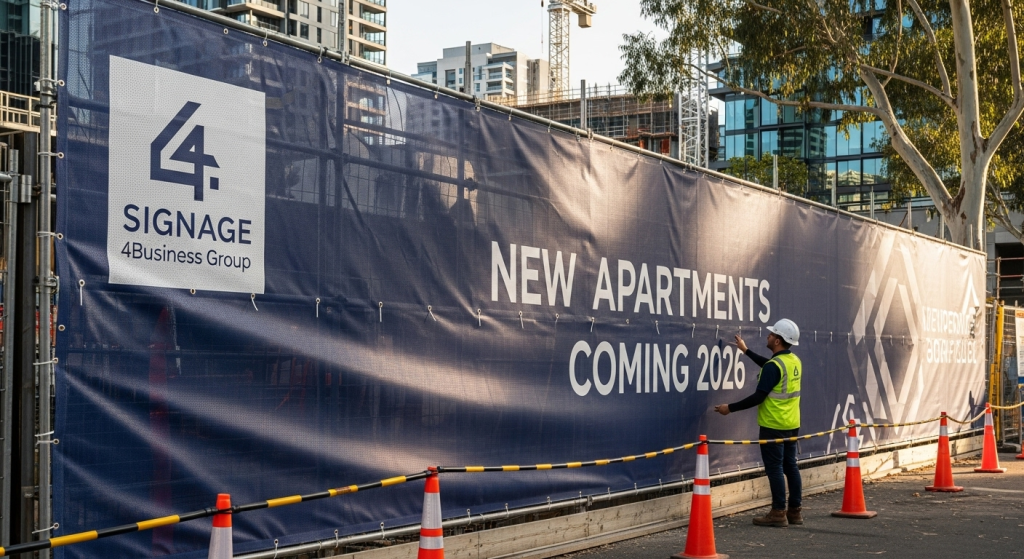
02. Mesh
Mesh banners are made from polyester-based fabric, where it is coated with PVC. Mesh banners are constructed with small perforations that allow wind to pass through.
The holes in the mesh banners reduce the strain on the material, prolonging its lifespan. This makes it a good choice for outdoor signage.
- Key Benefits and Characteristics
- Wind Resistant: The holes in the design allow air to pass through, minimising the risk of tear. This makes it ideal for windy areas, such as Brisbane.
- Lightweight and Easy to Install: Mesh banners are lightweight, making them easy to install in fences, buildings, and scaffolding.
- UV-Resistant: Vinyl-coated mesh material is one of the UV-resistant sign materials. It withstands warm and humid climates such as Brisbane’s.
- Popular Uses
Mesh signs are primarily used in large spaces like-
- Banner Mesh Australia provides privacy, safety and space to display company branding on construction sites.
- Custom mesh banners are popular for company branding in events like festivals, marathons, etc.
- Businesses use mesh banners to display promotional advertisements on external walls and fences. This capitalises on foot traffic in high-traffic areas.
03. Corflute
Corflute is a type of corrugated plastic made of polypropylene or polyethene. Corflute plastic sheets are formed by sandwiching two flat plastic sheets like fluted or wave-like plastic cores. The typical thickness of Corflute ranges from 3 to 5 mm.
Corflute signs outdoors are perfect for temporary campaigns and advertisements. This polypropylene signage is easy to install and transport. It has a decent level of durability and weather resistance while being affordable.
Corflute plastic has a bigger market worldwide, which indicates its popularity. The market value of Corflute plastic sheet is USD 3.9 billion worldwide in 2024. This is projected to be USD 5.89 Billion by 2031, with a growing CAGR of 5.3%.
- Key Benefits and Characteristics
- Cost-Effective: It is one of the most economical signage materials, especially for temporary signs.
- Weather Resistant: It is waterproof and moderately durable, making it perfect for temporary outdoor events display.
- Easy to Install and Remove: Ideal for events that need quick installation and removal.
- Popular Uses
- Corflute is frequently used for open house and political communications signage due to its low cost and easy disposal.
- They are also used as temporary construction signs to display project details and contact information.
- Used at events for directional signage and vendor information.
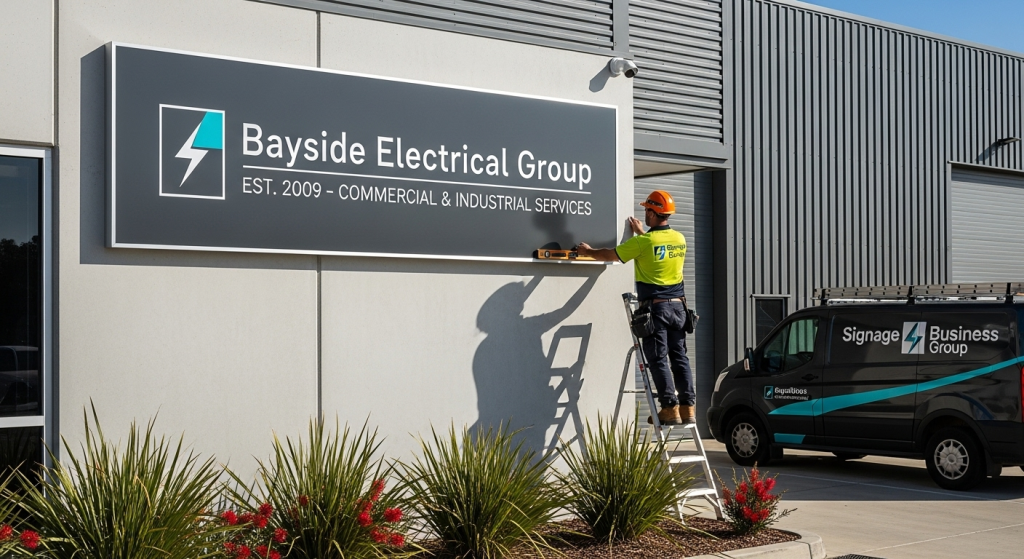
04. Acrylic
Acrylic material is made of a colourless, flammable liquid called acrylonitrile. The core material comes from polypropylene plastic.
It is another highly durable signage material with a breaking strength of 22,000 and 39,000 psi.
It is also waterproof and weatherproof and can filter up to 98% of harmful UV rays. This makes it a popular signage material for indoor and outdoor environments.
- Key Benefits and Characteristics
- Professional Look: Acrylic offers a high-quality professional look with a glossy finish.
- Durable: Acrylic is shatter-resistant and performs well in both indoor and outdoor settings.
- Customisable: It can be customised in any size, shape, and thickness. At the same time, you will get your desired colours and finishes to align with brand requirements.
- Popular Use
- A common choice for high-end office lobbies and corporate branding.
- Acrylic signage displays are used in high-end retail settings for product information due to their clarity.
05. Aluminium
Aluminium is a popular choice for outdoor and indoor signage. This is because of its lightweight nature, corrosion resistance, and durability.
Aluminium has natural corrosion resistance that can make it withstand for hundreds of years. It has a corrosion rate of 0.03 to 4 µm/year.
At the same time, the tensile strength of pure aluminium is around 90 MPa. This can go up to 690 MPa for some heat-treatable alloys.
- Key Benefits and Characteristics
- Rust-free durability makes it popular for long-term advertisement in the outdoors.
- With its UV-resistance nature, aluminium can withstand extreme sunlight for years.
- Being one of the lightweight signage materials, aluminium signs are easy to move and install.
- Popular Use
- Aluminium signs are used as outdoor wayfinding and directional signs where constant exposure to elements is required.
- Often used on the exterior of buildings, aluminium signage provides a professional look.
- Branding is used in retail and hospitality settings as permanent signage.
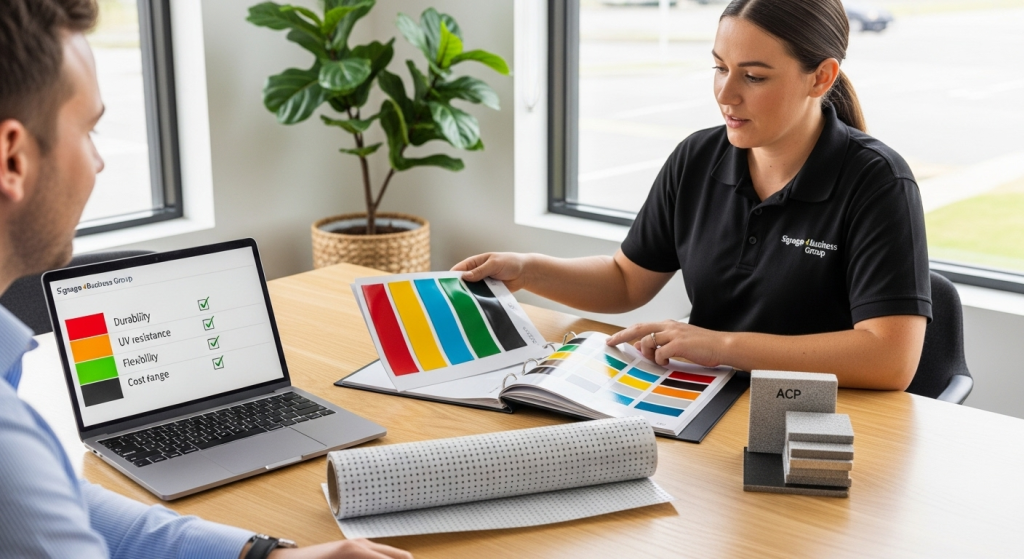
06. Aluminium Composite Material (ACM)
ACM (Aluminium Composite Material) signs are used for businesses that require long-lasting outdoor signage. It is composed of two thin aluminium sheets with a non-aluminium core that form an aluminium composite sheet. ACM features lightness along with exceptional durability
- Key Benefits and Characteristics
- Excellent Weather-Resistance: ACM signs are resistant to rust, corrosion, and UV exposure. It also has a very low water absorption percentage, which is only 0.18% to 0.25%, which means it is incredibly water-resistant.
- Lightweight But Sturdy: ACM is lightweight. But it is incredibly strong, which reduces structural strain.
- Versatile: ACM is compatible with various printing methods. This allows it for precise and vibrant graphics.
- Popular Uses
- ACM signs are often used on the exteriors of buildings for permanent branding. This is because of their durability and aesthetic appeal.
- Its weather-resistant properties make ACM suitable for durable directional signs.
- Retail businesses use ACM for large and high-quality outdoor displays. They are used to withstand environments continuously.
07. Steel
Both pure steel and stainless steel are known for their robustness and longevity. Steel is the most robust material used in making signage.
The tensile strength of steel generally ranges from 460 MPa to 690 MPa. On the other hand, the strength can go up to 190,000 PSI for stainless steel, which is equal to around 1310 MPa.
- Key Benefits and Characteristics
- High Tensile Strength: Steel is extremely strong and can ensure intense physical forces.
- Weather Resistance with Galvanisation: Stainless steel is more corrosion-resistant than normal steel. But, when treated with galvanisation, steel becomes highly resistant to rust and corrosion.
- Recyclable: Steel can be recycled without degrading its quality.
- Popular Uses
- Steel signs are used in construction sites in large and long projects that need to withstand rough conditions continuously.
- Steel signs are ideal for industrial-grade manufacturing facilities. In such environments, signs must endure heavy machinery and physical impact.
- Steel is often used for large outdoor sculptures and monument signs. This is because of its strength and timeless aesthetic.
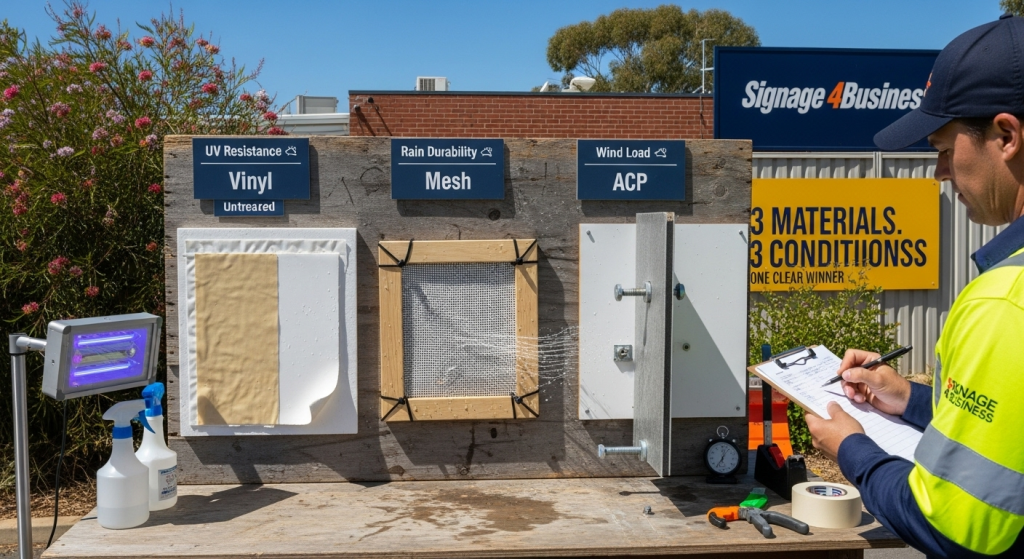
08. Brass
Brass offers a luxurious, classic appearance. Its aesthetic makes it a popular choice for high-end vintage-style signage.
Brass is a copper-zinc alloy which is resistant to corrosion. It is also highly durable, with an ultimate tensile strength ranging from 49000 to 68000 PSI. So, you can rely on brass for your branding signage.
- Key Benefits and Characteristics
- Classic and Aesthetic Look: Brass signage is popular for its elegant appearance and unique golden hue.
- Corrosion-Resistant with Patina Effect: You will see brasses get a patina effect over time. So, it will be corrosion resistant and get a change of colour in it with more aesthetic appeal.
- Requires Low Maintenance: Brass material is relatively easy to clean and maintain. So, it preserves its look with occasional polishing.
- Popular Uses
- Brass signs are popular in hotels, high-end retail stores, and settings, particularly in areas that desire more luxury and sophistication.
- Brass signs are often used for office nameplates and indoor plaques.
- Smaller boutiques and vintage stores often use brass signs for aesthetics.
09. Wood
Wood is a natural signage material. It is often used for rustic and eco-conscious branding. Though wood is durable and lasts long, its longevity depends on the types of wood used for signs.
- Key Benefits and Characteristics
- Weather Resistance with Treatment: Treated wood can withstand outdoor conditions for many years. However, untreated wood is suitable for indoor signage.
- Moderate to High Longevity: Wood like teak, ipe, oak, maple, mahogany, etc., has high longevity. On the other hand, pine, Douglas fir, cedar, etc., have low longevity.
- Eco-Friendly: Wood is eco-friendly since it is naturally biodegradable.
- Customisable and Versatile: Wood is highly customisable. You can paint, shape, engrave, and carve it to achieve various designs.
- Popular Uses
- Treated wood is often used for outdoor trail markers and park signs, blending with natural surroundings.
- Organic stores and cafes use wood signs for natural looks and sustainable branding.
- Restaurants, mainly family-owned, use indoor and outdoor wood signs to bring classic and rustic charm.

10. Foamboard/Foam Core Board
Foam board is made of polystyrene foam with a paper facing on either side. It is known for its lightweight and indoor signage options. It is also affordable and vastly available. All these make it one of the most popular signage materials for temporary signs.
- Key Benefits and Characteristics
- Lightweight and Customisable: Foam board or foam core is easy to cut, transport, and install.
- Foam board is cost-effective.
- Popular Use
- Indoor Foamboard Signs: Foamboard is frequently used for indoor displays. The usage is particularly for presentations or event-based temporary branding promotions. In such promotions, durability is the least concern.
How to Choose the Right Signage Materials
You need to consider different factors when choosing the right signage materials. Here’s a quick overview you should go through. Here’s a quick overview you should go through.
- Vinyl, aluminium, and steel are good choices for permanent signage due to their longevity and weather resistance.
- For temporary signage solutions and budget consciousness, foam board, vinyl, and Corflute are the best choices.
- For classic aesthetics, wood and brass are the go-to options.
- For eco-friendliness, wood, vinyl, and polypropylene Corflute are the best choices.
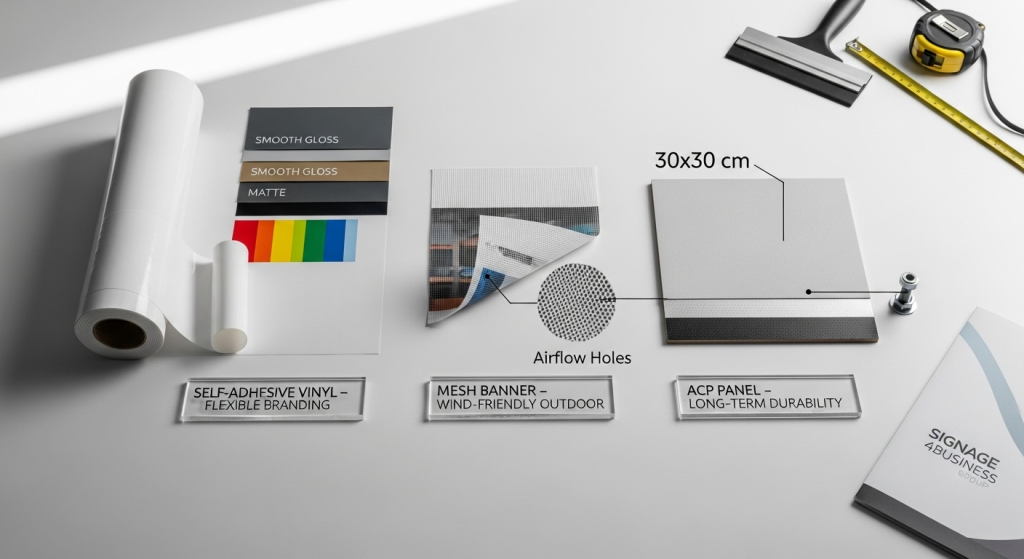
Final Words
Different types of signage materials are used in the signage industry. Vinyl, mesh, aluminium, steel, foam board, corflute, and many more materials are available. However, the material choice mainly depends on different factors.
If you want the best signage solutions, Signage 4Business Group is here in Brisbane to help you. After hearing your requirements, we offer you a free consultation about which signage materials you need. We offer customisations for signage that align with your business and branding goals. From design to signage installation, we assure you that you will get the best signage services in Brisbane. Contact us today and get the best signage solution for your business with peace of mind.